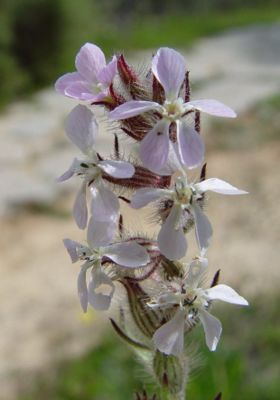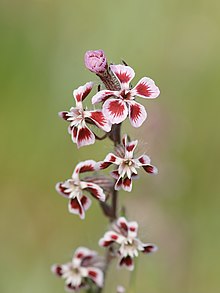French catchfly
| French catchfly | ||||||||||||
|---|---|---|---|---|---|---|---|---|---|---|---|---|

French catchfly ( Silene gallica ) |
||||||||||||
| Systematics | ||||||||||||
|
||||||||||||
| Scientific name | ||||||||||||
| Silene gallica | ||||||||||||
| L. |
The French Leimkraut ( Silene gallica ) is a species of the genus Leimkräuter ( Silene ) within the family of the carnation family (Caryophyllaceae).
description
Vegetative characteristics
The French catchfly is an annual herbaceous plant that reaches heights of 15 to 45 centimeters. The upright or ascending and simple or branched stem is hairy and glandular-sticky towards the top. The few foliage leaves arranged in a basal rosette are short-stalked, elongated spatulate and hairy. The remaining leaves are arranged opposite to one another on the stem and are sitting.
Generative characteristics
The flowering period extends from April to June. The grape-like inflorescence contains three to ten unilateral flowers . The lower flower stalks are up to one and a half times as long as the calyx, while the upper ones are shorter. The 7 to 10 millimeter long calyx is sharply toothed over a quarter of its length, long, wire-haired and has ten dark green nerves. It is initially cylindrical-ovoid in shape and later becomes ovoid and contracted at the tip. The 10 to 15 millimeter long petals are shallow or with entire margins and pink or white; every now and then they have a blood-red stain in their center. This variety is also known as the five-wound glue ( Silene gallica var. Quinquevulnera ).
The fruit carriers have a maximum length of 1 millimeter. The capsule fruit is 6 to 9 millimeters in size and has six recurved teeth. The dark brown seeds are warty and sharply serrated.
The number of chromosomes is 2n = 24.
Occurrence
The distribution area originally includes the Mediterranean , the Canary Islands , Madeira, the Azores, Western Asia and the Caucasus. Silene gallica is a neophyte in many areas of the world . It grows in Central Europe on fields, vineyards or rubble on more or less nutrient-rich, alternately dry, base-rich, often low-lime loam and clay soils. It is probably a species of the Secaalietea class, but also occurs in societies of the Chenopodietea class.
In Germany the species is threatened with extinction according to Floraweb. In Baden-Württemberg the species still had numerous occurrences in the sandstone areas of the Swabian-Franconian Forest before 1900, but the last observations of individual plants go back to the years 1980 to 1985.
Systematics
One can differentiate between the following varieties:
- Silene gallica var. Giraldii (cast.) Walters
- Five Wounds campion ( Silene gallica var. Quinquevulnera (L.) WDJ Koch )
literature
- Peter Schönfelder and Ingrid Schönfelder: What is in bloom in the Mediterranean? Franckh'sche Verlagsbuchhandlung, Stuttgart 1987, ISBN 3-440-05790-9 .
Individual evidence
- ↑ a b c Erich Oberdorfer : Plant-sociological excursion flora for Germany and neighboring areas. 8th edition. Verlag Eugen Ulmer, Stuttgart 2001, ISBN 3-8001-3131-5 . Page 362.
- ^ Silene in the Germplasm Resources Information Network (GRIN), USDA , ARS , National Genetic Resources Program. National Germplasm Resources Laboratory, Beltsville, Maryland. Retrieved September 8, 2017.
- ^ Siegmund Seybold : "Caryophyllaceae, Nelkengewächse". In Oskar Sebald u. a .: The fern and flowering plants of Baden-Württemberg. 2nd edition, volume 1, pages 443-445. Verlag Eugen Ulmer, Stuttgart 1993. ISBN 3-8001-3322-9
- ↑ Karol Marhold, 2011: Caryophyllaceae : Datasheet Silene gallica In: Euro + Med Plantbase - the information resource for Euro-Mediterranean plant diversity.
Web links
- Silene gallica L., nom. cons. prop., French catchfly. In: FloraWeb.de.
- Distribution map for Germany. In: Floraweb .
- Profile and distribution map for Bavaria . In: Botanical Information Hub of Bavaria .
- French catchfly . In: BiolFlor, the database of biological-ecological characteristics of the flora of Germany.
- Silene gallica at Plants For A Future
- Silene gallica L. In: Info Flora , the national data and information center for Swiss flora . Retrieved October 8, 2015.
- Thomas Meyer: [1]

